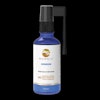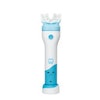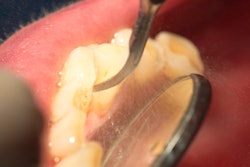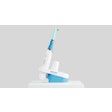
An approach to stopping caries that emphasizes prevention works in real-world dental practices, according to a new study published on January 22 in Advances in Dental Research. The strategy, caries management by risk assessment (CAMBRA), takes a proactive approach by targeting patients believed to have a high risk for caries.
Researchers recruited 21 dentists from private practices and community clinics who randomly assigned 460 patients to treatment with either the CAMBRA or a standard of care protocol. They found that the percentage of patients judged to have a high caries risk dropped significantly during 24 months of follow-up using the CAMBRA approach (Adv Dent Res, January 22, 2018).
"It really works, and it shows that the people who got the intervention had their caries risk come down dramatically," lead study author Peter Rechmann, DMD, PhD, told DrBicuspid.com.
Dr. Rechmann is a professor and the director of the Clinical Sciences Research Group at the University of California, San Francisco (UCSF) School of Dentistry.
The real world
The CAMBRA philosophy, which provides individualized, preventive, nonoperative treatment through the use of caries risk assessment and the use of antibacterial and fluoride products, was developed in California after two consensus conferences. Previous research has since shown its usefulness at reducing patients' bacterial load and caries risk in dental school settings.
“The people who got the intervention had their caries risk come down dramatically.”
The researchers of the current study sought to show CAMBRA's effectiveness in private dental practices. They recruited 30 Bay Area dentists for their practice-based research network (PBRN) study and trained them in caries risk assessment, carious lesions classification, and recording existing restorations. However, nine dentists dropped out of the study.
The dentists were also taught how to apply the International Caries Detection and Assessment System criteria for noncavitated lesions when examining their patients' decayed, missing, and filled surfaces (DMFS).
Of the trained dentists, 21 of them (18 private practice owners and three who worked for federally qualified health center community clinics) recruited patients from their organizations.
Patients were required to meet certain criteria, including the following:
- Be new to CAMBRA.
- Be between the ages of 12 and 65.
- Be unlikely to move from the area during the next two and a half years.
- Have at least 16 teeth.
- Complete restorative treatment of cavitated lesions before beginning the study.
The practitioners recorded DMFS data for each patient using a web-based dental charting program (Denticon, Planet DDS), which also provided secure data storage. After providing restorative treatment for all cavitated lesions and any other treatments needed, practitioners performed a caries risk assessment using MyCAMBRA, a computer algorithm developed at UCSF to assist private practitioners.
After classification of their caries risk level (low, moderate, or high), the patients in each risk level were randomly assigned to either the CAMBRA intervention or control group. Only one staff member in each office was aware of the patients' assignments to the two groups, with the rest blinded to the assignments.
Depending on their group assignments, patients were supplied with a specific six-month supply of oral healthcare products for home use, along with corresponding instructions, and these products were resupplied as needed. The products were concealed with labels so they could not be identified.
All control groups were given Crest Cavity Protection toothpaste (Procter & Gamble) to use twice daily. The patients with moderate or high caries risks were also given Crest Scope mouthrinse (Procter & Gamble) to be used daily and sorbitol candies (Epic Dental) to be eaten four times each day. The high-risk control group also received placebo varnish.
The products given to the patients in the intervention groups differed somewhat. The low-and moderate-risk groups were also given the Crest Cavity Protection toothpaste, but the moderate-risk group also received Ortho wash rinse (3M ESPE) to use daily and xylitol candies to be eaten four times a day. The high-risk group was given Clinpro 5000 toothpaste (3M) and Peridex chlorhexidine gluconate rinse (3M) to be used daily, along with xylitol candies (Epic) to be eaten four times a day. These patients also received Vanish fluoride varnish (3M).
The patients were scheduled for recall examinations after six, 12, 18, and 24 months. Four bitewing radiographs for each participant were taken at baseline and repeated every six months in the high-risk group and every 12 months in the other groups. Each patient was also scheduled for dental prophylaxis with oral hygiene instructions every six months.
At baseline, 192 patients were classified as having a low caries risk, 26 with a moderate risk, and 242 with a high risk. At the end of the study period, both the intervention and control groups had lower percentages of high-risk patients, but the percentage was significantly lower in the intervention group (25% versus 53.8%).
| Impact of CAMBRA on patients with a high caries risk | |||
| Exam | No. of high-risk patients | Control group | CAMBRA group |
| Baseline | 242 | 105 | 137 |
| 6 months | 137 | 43/57 (75.4%) | 49/80 (61.3%) |
| 12 months | 116 | 30/47 (63.8) | 30/69 (43.5%) |
| 18 months | 95 | 19/41 (46.3%) | 13/54 (24.1%) |
| 24 months | 83 | 21/39 (53.8%) | 11/44 (25%) |
For patients who began the study classified as having a low caries risk, fewer in the intervention group progressed to moderate or high risk than in the control group.
| Impact of CAMBRA on patients with low caries risk | |||
| Exam | No. of moderate- or high-risk patients | Control group | CAMBRA group |
| Baseline | 192 | 0/99 | 0/93 |
| 6 months | 136 | 7/72 (9.7%) | 5/64 (7.8%) |
| 12 months | 126 | 11/70 (15.7) | 3/56 (5.4%) |
| 18 months | 112 | 9/59 (15.3%) | 2/53 (3.8%) |
| 24 months | 85 | 11/49 (22.5%) | 4/36 (11.1%) |
High attrition rate
The authors acknowledged that the participant attrition rate for this study was high (65%), despite dentists given incentives to participate and provided with products for patients in both study groups. They also noted the challenges in tracking patient compliance with using the provided products at home.
However, the authors concluded that CAMBRA was an effective strategy in dental practices.
"The CAMBRA-PBRN study ... showed the percentage of participants assessed as high caries risk at baseline dropped constantly over the observation period of 24 months to 25% for the intervention group applying CAMBRA preventive interventions," they wrote.



















